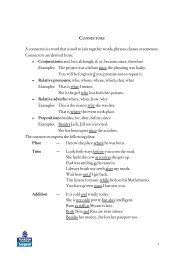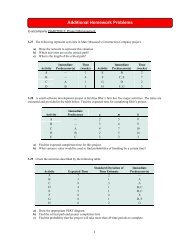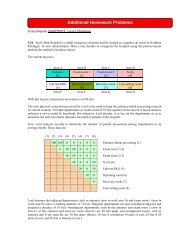The Economy at Full Employment - Pearson
The Economy at Full Employment - Pearson
The Economy at Full Employment - Pearson
You also want an ePaper? Increase the reach of your titles
YUMPU automatically turns print PDFs into web optimized ePapers that Google loves.
Chapter<br />
7 THE<br />
ECONOMY AT<br />
FULL EMPLOYMENT*<br />
Key Concepts<br />
FIGURE 7.1<br />
Production Function<br />
Real GDP and <strong>Employment</strong><br />
A production possibility frontier between real GDP and<br />
leisure shows th<strong>at</strong> GDP can be increased if time spent<br />
<strong>at</strong> leisure is decreased, th<strong>at</strong> is, if employment increases.<br />
<strong>The</strong> production function shows the rel<strong>at</strong>ionship between<br />
real GDP and the quantity of labor employed<br />
when all other influences in production remain the<br />
same. A production function is illustr<strong>at</strong>ed in Figure 7.1.<br />
♦ When employment increases, there is a movement<br />
along the production function, as illustr<strong>at</strong>ed by the<br />
movement from point a to point b along PF 0 .<br />
An increase in labor productivity, real GDP per hour<br />
of work, shifts the production function upward, as illustr<strong>at</strong>ed<br />
by the shift from PF 0 to PF 1.<br />
Labor productivity<br />
increases with:<br />
♦ increases in physical capital;<br />
♦ increases in human capital, people’s skill and<br />
training obtained from educ<strong>at</strong>ion and on-the-job<br />
training via learning-by-doing;<br />
♦ increase in technology.<br />
In the United St<strong>at</strong>es, capital accumul<strong>at</strong>ion and technological<br />
change have shifted the production function<br />
upward.<br />
Labor Market and Aggreg<strong>at</strong>e Supply<br />
<strong>The</strong> demand for labor and the supply of labor depend<br />
on the real wage r<strong>at</strong>e, the quantity of goods and services<br />
an hour of labor earns. <strong>The</strong> money wage r<strong>at</strong>e is<br />
the number of dollars an hour of labor earns.<br />
♦ <strong>The</strong> real wage r<strong>at</strong>e equals the money wage r<strong>at</strong>e<br />
divided by the price level.<br />
Real GDP (trillions of 1996 dollars)<br />
16<br />
14<br />
12<br />
10<br />
8<br />
a<br />
PF 1<br />
PF 0<br />
200 400<br />
Labor (billions of hours per year)<br />
<strong>The</strong> demand for labor is the rel<strong>at</strong>ionship between the<br />
real wage r<strong>at</strong>e and the quantity of labor firms demand,<br />
where the quantity of labor demanded is the number<br />
of labor hours hired by all the firms in the economy. As<br />
the real wage r<strong>at</strong>e increases, the quantity of labor demanded<br />
decreases.<br />
♦<br />
<strong>The</strong> marginal product of labor is the additional<br />
real GDP produced by an additional hour of labor.<br />
<strong>The</strong> law of diminishing returns points out th<strong>at</strong> as<br />
the quantity of labor increases, other things the<br />
same, the marginal product diminishes.<br />
♦ Because the marginal product of labor diminishes<br />
as employment increases, firms will hire additional<br />
workers only if the real wage r<strong>at</strong>e falls. Thus the<br />
labor demand curve, LD, slopes downward, as illustr<strong>at</strong>ed<br />
in Figure 7.2 (on the next page).<br />
♦ <strong>The</strong> demand for labor increases when the marginal<br />
product of labor increases.<br />
b<br />
* This is Chapter 22 in Economics.<br />
109
110<br />
CHAPTER 7 (22)<br />
FIGURE 7.2<br />
<strong>The</strong> Labor Market<br />
Real wage r<strong>at</strong>e (1996 dollars per hour)<br />
35<br />
LS<br />
LD<br />
200<br />
Labor (billions of hours per year)<br />
<strong>The</strong> supply of labor is the rel<strong>at</strong>ionship between the<br />
quantity of labor supplied and the real wage r<strong>at</strong>e when<br />
all other influences on work plans remain the same.<br />
♦ <strong>The</strong> labor supply curve, LS, slopes upward, as illustr<strong>at</strong>ed<br />
in Figure 7.2, because higher real wage<br />
r<strong>at</strong>es increase the amount of goods and services th<strong>at</strong><br />
can be purchased for an hour’s work.<br />
In Figure 7.2 the equilibrium real wage r<strong>at</strong>e is $35 per<br />
hour and equilibrium employment is 200 billion hours.<br />
♦ <strong>The</strong> equilibrium quantity of employment from the<br />
labor market and the production function determine<br />
potential GDP. <strong>The</strong> long-run aggreg<strong>at</strong>e<br />
supply curve, LAS, is the rel<strong>at</strong>ionship between the<br />
quantity of real GDP supplied and the price level<br />
when real GDP equals potential GDP. <strong>The</strong> LAS<br />
curve is vertical <strong>at</strong> potential GDP.<br />
♦ In the short run, the labor market can depart from<br />
full employment. <strong>The</strong> short-run aggreg<strong>at</strong>e supply<br />
curve, SAS, is the rel<strong>at</strong>ionship between the quantity<br />
of real GDP supplied and the price level when the<br />
money wage r<strong>at</strong>e and potential GDP remain constant.<br />
<strong>The</strong> SAS curve is upward sloping.<br />
♦ If the price level rises and the money wage does not<br />
change, the real wage falls. Firms hire more workers,<br />
real GDP increases and the economy moves<br />
along the SAS curve. A shortage of labor results so<br />
th<strong>at</strong> the money wage r<strong>at</strong>e rises. Eventually the real<br />
wage r<strong>at</strong>e returns to its equilibrium and GDP again<br />
equals potential GDP.<br />
Changes in Potential GDP<br />
Real GDP increases if the economy recovers from a<br />
recession or it potential GDP increases. Potential GDP<br />
increases if the popul<strong>at</strong>ion increases or if labor productivity<br />
increases.<br />
♦ An increase in popul<strong>at</strong>ion increases the supply of<br />
labor so th<strong>at</strong> the labor supply curve shifts rightward.<br />
<strong>The</strong> production function does not shift. <strong>Employment</strong><br />
increases and the economy moves along<br />
its (unchanged) production function to a higher<br />
level of potential GDP.<br />
♦ An increase in labor productivity (because of an<br />
increase in physical capital, human capital, or technology)<br />
shifts the production function upward and<br />
increases the demand for labor. <strong>Employment</strong> increases<br />
because of the increase in demand for labor.<br />
Potential GDP increases because employment increases<br />
and because the production function has<br />
shifted upward.<br />
In the United St<strong>at</strong>es, over the last twenty years, the<br />
popul<strong>at</strong>ion increased, thereby increasing the supply of<br />
labor. <strong>The</strong> demand for labor increased because the<br />
capital stock increased and because technology advanced.<br />
Both these last two factors increased productivity<br />
and thus shifted the production function upward.<br />
So potential GDP has increased because equilibrium<br />
employment has increased and because the production<br />
function has shifted upward.<br />
Unemployment <strong>at</strong> <strong>Full</strong> <strong>Employment</strong><br />
Two factors help explain why unemployment is always<br />
present even <strong>at</strong> full employment (when the unemployment<br />
r<strong>at</strong>e equals the n<strong>at</strong>ural r<strong>at</strong>e of unemployment):<br />
♦ Job search — the activity of looking for an acceptable<br />
vacant job. <strong>The</strong> length of time spent searching,<br />
and hence the n<strong>at</strong>ural r<strong>at</strong>e of unemployment, increases<br />
when more young people enter the labor<br />
market; when unemployment compens<strong>at</strong>ion payments<br />
become more generous; and when structural<br />
change in the economy increases.<br />
♦ Job r<strong>at</strong>ioning — paying workers an aboveequilibrium<br />
wage r<strong>at</strong>e and then r<strong>at</strong>ioning jobs by<br />
some method. Jobs can be r<strong>at</strong>ioned because of efficiency<br />
wages (paying a higher wage r<strong>at</strong>e to increase<br />
productivity) or because of a minimum wage law<br />
(which sets the lowest legal wage a firm can pay)<br />
th<strong>at</strong> prevents some workers from finding jobs.
THE ECONOMY AT FULL EMPLOYMENT 111<br />
Helpful Hints<br />
1. FROM THE LABOR MARKET TO POTENTIAL GDP :<br />
<strong>The</strong> production function stands between the labor<br />
market and the aggreg<strong>at</strong>e output market. <strong>The</strong> equilibrium<br />
level of employment is determined in the<br />
labor market and then the production function indic<strong>at</strong>es<br />
how much output results from th<strong>at</strong> level of<br />
employment.<br />
<strong>The</strong> labor market functions like the “typical” supply<br />
and demand markets you studied in Chapter 3.<br />
Everything you learned there about how to use the<br />
supply and demand model applies to the labor<br />
market in this chapter. In particular, the key difference<br />
between shifts in a curve versus movements<br />
along a curve continues to apply: Changes in the<br />
real wage r<strong>at</strong>e cre<strong>at</strong>e movements along the labor<br />
demand and labor supply curves while other relevant<br />
factors shift these curves.<br />
2. PRODUCTION FUNCTION : <strong>The</strong> production function<br />
graphically illustr<strong>at</strong>es the rel<strong>at</strong>ionship between<br />
the amount of labor employment and the level of<br />
real GDP.<br />
In the next chapters you will meet a similar concept,<br />
the “productivity function”. <strong>The</strong> productivity<br />
function rel<strong>at</strong>es output per hour of work to capital<br />
per hour of work. Graphically, the productivity<br />
function appears similar to the production function.<br />
<strong>The</strong> productivity function is rel<strong>at</strong>ed to the<br />
production function but it is not the same. Thoroughly<br />
study the production function now so th<strong>at</strong><br />
you are not confused between the two when you<br />
study the productivity function.<br />
Questions<br />
True/False and Explain<br />
Real GDP and <strong>Employment</strong><br />
11. If the production possibilities frontier does not<br />
shift, real GDP can be increased only if leisure is<br />
increased.<br />
12. An increase in employment causes a movement<br />
along the production function.<br />
13. Labor productivity increases when the amount of<br />
the n<strong>at</strong>ion’s human capital increases.<br />
14. Learning-by-doing increases the n<strong>at</strong>ion’s physical<br />
capital.<br />
15. In the United St<strong>at</strong>es, there have been movements<br />
along the U.S. production function but no shifts in<br />
the function.<br />
Labor Market and Aggreg<strong>at</strong>e Supply<br />
16. <strong>The</strong> demand for labor curve is downward sloping.<br />
17. As more workers are employed, the marginal product<br />
of labor increases.<br />
18. A rise in the real wage r<strong>at</strong>e increases the quantity of<br />
labor supplied.<br />
19. When employment equals the equilibrium quantity,<br />
the economy is on its LAS curve.<br />
Changes in Potential GDP<br />
10. An increase in the demand for labor raises the real<br />
wage r<strong>at</strong>e.<br />
11. An increase in the demand for labor increases potential<br />
GDP.<br />
12. An increase in the n<strong>at</strong>ion’s physical capital stock<br />
decreases the demand for labor.<br />
13. An increase in labor productivity shifts the production<br />
function downward and decreases the quantity<br />
of employment.<br />
14. Since 1980 in the United St<strong>at</strong>es, the supply of labor<br />
has increased more than the demand for labor.<br />
Unemployment <strong>at</strong> <strong>Full</strong> <strong>Employment</strong><br />
15. When the unemployment r<strong>at</strong>e equals the n<strong>at</strong>ural<br />
r<strong>at</strong>e, there is no job search.<br />
16. An increase in unemployment compens<strong>at</strong>ion will<br />
decrease job search.<br />
17. Efficiency wages can be a cause of unemployment.<br />
Multiple Choice<br />
Real GDP and <strong>Employment</strong><br />
11. <strong>The</strong> production possibilities frontier between real<br />
GDP and leisure<br />
a. shifts inward when the capital stock increases<br />
because unemployment rises.<br />
b. shows th<strong>at</strong> increasing leisure will decrease real<br />
GDP.<br />
c. shifts if employment increases.<br />
d. All of the above answers are correct.
112<br />
CHAPTER 7 (22)<br />
12. Which of the following shifts the n<strong>at</strong>ion’s production<br />
function upward?<br />
a. An increase in employment.<br />
b. A decrease in employment.<br />
c. An increase in human capital.<br />
d. A decrease in human capital.<br />
13. A movement along the production function with no<br />
shift in the production function is cre<strong>at</strong>ed by<br />
a. changes in the amount of physical capital.<br />
b. changes in the amount of human capital.<br />
c. advances in technology.<br />
d. changes in employment.<br />
14. Between 1980 and 2001, the U.S. production function<br />
shifted ____ and the quantity of labor hours<br />
____.<br />
a. upward; increased<br />
b. upward; decreased<br />
c. downward; increased<br />
d. downward; decreased<br />
Labor Market and Aggreg<strong>at</strong>e Supply<br />
15. <strong>The</strong> money wage r<strong>at</strong>e is $10 per hour and the price<br />
level is 100. If the price level rises to 200 and the<br />
money wage r<strong>at</strong>e does not change, wh<strong>at</strong> happens to<br />
the real wage r<strong>at</strong>e?<br />
a. <strong>The</strong> real wage r<strong>at</strong>e doubles.<br />
b. <strong>The</strong> real wage r<strong>at</strong>e rises, but does not double.<br />
c. <strong>The</strong> real wage r<strong>at</strong>e does not change.<br />
d. <strong>The</strong> real wage r<strong>at</strong>e falls.<br />
16. Five workers produce total output of $200; six<br />
workers produce total output of $222. <strong>The</strong> marginal<br />
product of the sixth worker equals<br />
a. $40.<br />
b. $37.<br />
c. $22.<br />
d. None of the above answers is correct.<br />
17. <strong>The</strong> demand curve for labor is downward sloping<br />
because the<br />
a. marginal product of labor diminishes as more<br />
workers are employed.<br />
b. supply curve of labor is upward sloping.<br />
c. demand curve shifts when capital increases.<br />
d. None of the above answers are correct because<br />
the demand curve for labor is upward sloping.<br />
18. As the real wage r<strong>at</strong>e increases, the quantity of labor<br />
supplied increases<br />
a. only because people already working increase the<br />
quantity of labor they supply.<br />
b. only because the higher wage r<strong>at</strong>e increases labor<br />
force particip<strong>at</strong>ion.<br />
c. because people already working increase the<br />
quantity of labor they supply and because the<br />
higher wage r<strong>at</strong>e increases labor force particip<strong>at</strong>ion.<br />
d. None of the above answers is correct because an<br />
increase in the real wage r<strong>at</strong>e decreases the quantity<br />
of labor supplied.<br />
19. A rise in the real wage r<strong>at</strong>e<br />
a. shifts the labor demand curve rightward.<br />
b. shifts the labor demand curve leftward.<br />
c. shifts the labor supply curve leftward.<br />
d. does not shift the labor demand or labor supply<br />
curve.<br />
10. If the economy is <strong>at</strong> full employment, the<br />
a. entire popul<strong>at</strong>ion is employed.<br />
b. entire labor force is employed.<br />
c. long-run aggreg<strong>at</strong>e supply curve is upward sloping.<br />
d. the quantity of labor supplied equals the quantity<br />
of labor demanded.<br />
11. At potential GDP,<br />
a. the labor market is in equilibrium, with the<br />
quantity of labor demanded equal to the quantity<br />
supplied.<br />
b. there is no necessary rel<strong>at</strong>ionship between the<br />
quantity of labor demanded and the quantity<br />
supplied.<br />
c. the real wage has adjusted so th<strong>at</strong> it equals the<br />
money wage.<br />
d. the real wage r<strong>at</strong>e must be rising because otherwise<br />
people will not work.<br />
Changes in Potential GDP<br />
12. An increase in popul<strong>at</strong>ion shifts the<br />
a. labor demand curve rightward.<br />
b. labor demand curve leftward.<br />
c. labor supply curve rightward.<br />
d. labor supply curve leftward.
THE ECONOMY AT FULL EMPLOYMENT 113<br />
13. An increase in productivity from new technology<br />
shifts the production function ____ and shifts the<br />
demand for labor curve ____.<br />
a. upward; rightward<br />
b. upward; leftward<br />
c. downward; rightward<br />
d. downward; leftward<br />
14. An increase in the demand for labor ____ the real<br />
wage and ____ the quantity of employment.<br />
a. raises; increases<br />
b. raises; decreases<br />
c. lowers; increases<br />
d. lowers; decreases<br />
15. Which of the following will NOT increase labor<br />
productivity?<br />
a. An increase in physical capital.<br />
b. An increase in human capital.<br />
c. An increase in employment.<br />
d. An advance in technology.<br />
16. In the United St<strong>at</strong>es, from 1981 to 2001, the demand<br />
for labor has<br />
a. increased more than the supply of labor has<br />
increased.<br />
b. increased less than the supply of labor increased.<br />
c. increased while the supply of labor has decreased.<br />
d. decreased while the supply of labor has increased<br />
17. <strong>The</strong> demand for labor and the supply of labor are<br />
both increasing over time, but the demand for labor<br />
is increasing <strong>at</strong> a faster r<strong>at</strong>e. Over time, therefore,<br />
you would expect to see the real wage r<strong>at</strong>e ____ and<br />
employment ____.<br />
a. rise; increase<br />
b. rise; decrease<br />
c. fall; increase<br />
d. fall; decrease<br />
Unemployment <strong>at</strong> <strong>Full</strong> <strong>Employment</strong><br />
18. An increase in unemployment compens<strong>at</strong>ion payments<br />
will<br />
a. decrease the extent of search unemployment.<br />
b. lead to more job r<strong>at</strong>ioning.<br />
c. decrease the extent of demographic change.<br />
d. increase the length of time a worker searches for<br />
a job.<br />
19. Which of the following is a reason th<strong>at</strong> jobs might<br />
be r<strong>at</strong>ioned?<br />
a. Efficiency wages<br />
b. Equilibrium real wage r<strong>at</strong>e.<br />
c. <strong>The</strong> vertical LAS curve.<br />
d. An increase in the demand for labor<br />
20. An efficiency wage refers to<br />
a. workers being paid wages below the equilibrium<br />
wage r<strong>at</strong>e in order to increase the economy’s<br />
efficiency.<br />
b. wages being set to gener<strong>at</strong>e the efficient level of<br />
unemployment.<br />
c. workers being paid wages above the equilibrium<br />
wage r<strong>at</strong>e in order to increase their productivity.<br />
d. None of the above.<br />
21. Suppose th<strong>at</strong> the real wage r<strong>at</strong>e is above the equilibrium<br />
real wage r<strong>at</strong>e. <strong>The</strong>n the quantity demanded of<br />
labor ___ the quantity supplied of labor and there<br />
____ unemployment.<br />
a. is more than; is<br />
b. is more than; is not<br />
c. is less than; is not<br />
d. is less than; is<br />
Short Answer Problems<br />
1. Wh<strong>at</strong> is the connection between the production<br />
possibilities frontier showing the rel<strong>at</strong>ionship between<br />
leisure and real GDP and the production<br />
function showing the rel<strong>at</strong>ionship between employment<br />
and real GDP?<br />
2. a. Wh<strong>at</strong> does diminishing returns mean?<br />
b. Moving along a production function, why does<br />
the marginal product of labor diminish as employment<br />
increases?<br />
3. Why is the marginal product of labor curve the<br />
same as the labor demand curve? Wh<strong>at</strong> does this<br />
equality imply for the slope of the labor demand<br />
curve?<br />
4. a. Wh<strong>at</strong> is the real wage r<strong>at</strong>e? How does it differ<br />
from the money r<strong>at</strong>e? How is the real wage r<strong>at</strong>e<br />
constructed?<br />
b. Why does the supply of labor depend on the<br />
real wage r<strong>at</strong>e r<strong>at</strong>her than the money wage r<strong>at</strong>e?
114<br />
CHAPTER 7 (22)<br />
FIGURE 7.3<br />
Short Answer Problem 5<br />
FIGURE 7.4<br />
Short Answer Problem 7<br />
Real wage r<strong>at</strong>e (1996 dollars per hour)<br />
25<br />
20<br />
15<br />
10<br />
5<br />
LS<br />
LD<br />
Real GDP (trillions of 1996 dollars)<br />
17<br />
15<br />
13<br />
11<br />
10<br />
PF<br />
0<br />
50<br />
100 150 200 250<br />
Labor (billions of hours per year)<br />
200 300 400<br />
Labor (billions of hours per year)<br />
5. In Figure 7.3 wh<strong>at</strong> is the equilibrium real wage<br />
r<strong>at</strong>e? Illustr<strong>at</strong>e a real wage r<strong>at</strong>e <strong>at</strong> which jobs are r<strong>at</strong>ioned.<br />
Indic<strong>at</strong>e the amount of unemployment.<br />
6. Wh<strong>at</strong> can account for job r<strong>at</strong>ioning?<br />
7. Suppose th<strong>at</strong> new technology shifts the production<br />
function upward and increases labor productivity.<br />
Using Figures 7.4 and 7.5, show wh<strong>at</strong> happens in<br />
both. Does the equilibrium quantity of employment<br />
rise or fall? Does real GDP increase or decrease?<br />
You’re the Teacher<br />
1. “Look, I really studied this chapter, but why<br />
bother? I mean, I thought we were going to be<br />
learning about stuff like money, and recessions, and<br />
stuff like th<strong>at</strong>. I know th<strong>at</strong> unemployment is important,<br />
but why do we bother to study unemployment<br />
<strong>at</strong> full employment?” It is undoubtedly<br />
good th<strong>at</strong> your friend has been studying this chapter,<br />
but it undoubtedly would be better if your<br />
friend understood why this chapter is important.<br />
Can you help your friend grasp this key point?<br />
FIGURE 7.5<br />
Short Answer Problem 7<br />
Real wage r<strong>at</strong>e (1996 dollars per hour)<br />
LS<br />
21<br />
14<br />
7<br />
LD<br />
100 200 300 400<br />
Labor (billions of hours per year)
THE ECONOMY AT FULL EMPLOYMENT 115<br />
True/False Answers<br />
Answers<br />
Real GDP and <strong>Employment</strong><br />
11. F Increasing leisure decreases employment and<br />
hence decreases real GDP.<br />
12. T An increase in employment causes a movement<br />
along the production function to a higher level<br />
of real GDP.<br />
13. T When productivity increases, the n<strong>at</strong>ion’s production<br />
function shifts upward.<br />
14. F Learning-by-doing increases human capital, not<br />
physical capital.<br />
15. F <strong>The</strong> U.S. production function has shifted upward<br />
because of increases in capital and advances<br />
in technology.<br />
Labor Market and Aggreg<strong>at</strong>e Supply<br />
16. T <strong>The</strong> demand for labor curve is downward sloping<br />
because the marginal product of labor diminishes<br />
as more workers are employed.<br />
17. F As more workers are employed, the marginal<br />
product diminishes.<br />
18. T If the real wage r<strong>at</strong>e rises, more workers enter the<br />
labor force and workers already in the labor<br />
force supply more hours of work.<br />
19. T Equilibrium employment is full employment,<br />
which means the economy is <strong>at</strong> potential GDP<br />
on its LAS curve.<br />
Changes in Potential GDP<br />
10. T An increase in the demand for labor raises both<br />
the real wage r<strong>at</strong>e and employment.<br />
11. T Because an increase in the demand for labor<br />
increases employment, it also increases potential<br />
GDP.<br />
12. F An increase in capital raises the marginal product<br />
of labor, which increases the demand for labor.<br />
13. F An increase in productivity shifts the production<br />
function upward and increases the quantity of<br />
employment.<br />
14. F <strong>The</strong> demand for labor has increased by more<br />
than the supply of labor and, as a result, the real<br />
wage has risen.<br />
Unemployment <strong>at</strong> <strong>Full</strong> <strong>Employment</strong><br />
15. F Job search always exists.<br />
16. F An increase in unemployment compens<strong>at</strong>ion<br />
cre<strong>at</strong>es more job search and hence increases unemployment.<br />
17. T When wages are set above the equilibrium level,<br />
unemployment results.<br />
Multiple Choice Answers<br />
Real GDP and <strong>Employment</strong><br />
11. b If leisure increases, people are spending less time<br />
<strong>at</strong> work. As a result, real GDP decreases.<br />
12. c Changes in employment, answers (a) and (b),<br />
cre<strong>at</strong>e movements along the production function.<br />
An increase in human capital shifts the<br />
production function upward.<br />
13. d As the previous answer pointed out, changes in<br />
employment cre<strong>at</strong>e a movement along the production<br />
function. Changes in other relevant<br />
factors shift the production function.<br />
14. a <strong>The</strong> production function shifted upward because<br />
of increases in productivity.<br />
Labor Market and Aggreg<strong>at</strong>e Supply<br />
15. d <strong>The</strong> real wage r<strong>at</strong>e equals the money wage r<strong>at</strong>e<br />
divided by the price level so when the price level<br />
rises and the money wage r<strong>at</strong>e does not change,<br />
the real wage r<strong>at</strong>e falls<br />
16. c <strong>The</strong> marginal product of labor equals the change<br />
in output divided by the change in employment,<br />
or, in this case, ($222 – $200)/(6 – 5) = $22.<br />
17. a <strong>The</strong> demand for labor curve is the same as the<br />
marginal product of labor curve.<br />
18. c For both reasons given in the answer, the supply<br />
of labor curve is upward sloping, indic<strong>at</strong>ing th<strong>at</strong><br />
an increase in the real wage r<strong>at</strong>e increases the<br />
quantity of labor supplied.<br />
19. d A change in the real wage r<strong>at</strong>e cre<strong>at</strong>es a movement<br />
along the labor demand and labor supply<br />
curves but does not shift either curve.<br />
10. d When the labor market is in equilibrium, the<br />
economy is <strong>at</strong> full employment.<br />
11. a When the labor market is in equilibrium — the<br />
quantity of labor supplied equals the quantity of<br />
labor demanded — the economy is producing its<br />
potential GDP.
116<br />
CHAPTER 7 (22)<br />
Changes in Potential GDP<br />
12. c With more people, the supply of labor increases.<br />
13. a <strong>The</strong> increase in productivity increases the marginal<br />
product of labor, which shifts the demand<br />
for labor curve rightward.<br />
14. a As Figure 7.6 illustr<strong>at</strong>es, the increase in the demand<br />
for labor is reflected in the rightward shift<br />
in the demand curve from LD 0 to LD 1 . <strong>The</strong><br />
wage r<strong>at</strong>e rises from $10 an hour to $15 and the<br />
level of employment increases from 100 billion<br />
hours to 150 billion. This answer demonstr<strong>at</strong>es<br />
how an increase in productivity and the resulting<br />
increase in the demand for labor (the last question)<br />
results in a higher real wage r<strong>at</strong>e.<br />
FIGURE 7.6<br />
Multiple Choice Question 14<br />
Real wage r<strong>at</strong>e (1996 dollars per hour)<br />
25<br />
20<br />
15<br />
10<br />
5<br />
0<br />
50<br />
LS<br />
LD 0<br />
LD 1<br />
100 150 200 250<br />
Labor (billions of hours per year)<br />
15. c By itself, an increase in employment will cre<strong>at</strong>e a<br />
movement along the production function to a<br />
lower level of productivity.<br />
16. a Because the demand for labor has increased<br />
more than the supply of labor, the real wage r<strong>at</strong>e<br />
has risen.<br />
17. a <strong>The</strong> situ<strong>at</strong>ion outlined in the question is wh<strong>at</strong><br />
occurred in the United St<strong>at</strong>es, so in the United<br />
St<strong>at</strong>es employment and the real wage r<strong>at</strong>e have<br />
increased.<br />
Unemployment <strong>at</strong> <strong>Full</strong> <strong>Employment</strong><br />
18. d Unemployment compens<strong>at</strong>ion payments reduce<br />
the cost of being unemployed, so an increase in<br />
these payments makes unemployed workers<br />
more willing to search for longer periods of time<br />
to find better jobs.<br />
19. a Efficiency wages and the minimum wage both<br />
can lead to job r<strong>at</strong>ioning.<br />
20. c Answer (c) is the definition of an efficiency<br />
wage.<br />
21. d With the real wage r<strong>at</strong>e above the equilibrium<br />
wage r<strong>at</strong>e, there are workers who cannot find<br />
jobs and these workers are unemployed.<br />
Answers to Short Answer Problems<br />
1. <strong>The</strong> production possibilities frontier and the production<br />
function are basically opposite sides of the<br />
same coin.<br />
<strong>The</strong> production possibilities frontier shows th<strong>at</strong> if<br />
leisure is decreased — so th<strong>at</strong> employment is increased<br />
— then real GDP increases. Because of increasing<br />
opportunity cost, the production<br />
possibilities frontier also shows th<strong>at</strong> as more additional<br />
time is spent in employment, the additional<br />
GDP th<strong>at</strong> results diminishes.<br />
<strong>The</strong> production function shows similar results. <strong>The</strong><br />
production function demonstr<strong>at</strong>es th<strong>at</strong> if employment<br />
increases, real GDP increases. Because of diminishing<br />
returns, the production function also<br />
shows th<strong>at</strong> as employment increases, the additional<br />
GDP th<strong>at</strong> results diminishes.<br />
2. a. Diminishing returns means th<strong>at</strong> as the quantity<br />
of labor increases, the additional GDP th<strong>at</strong> results<br />
diminishes. In other words, the 1,000,001st<br />
hour of labor by itself cre<strong>at</strong>es less additional<br />
GDP than does the 1,000,000th hour of labor.<br />
b. Moving along a production function, the marginal<br />
product of labor diminishes because along<br />
the production function the amount of the<br />
capital stock and technology are constant. Thus<br />
additional labor must work with the same number<br />
of factories, assembly lines, and so forth. In<br />
this situ<strong>at</strong>ion, an added worker might not cre<strong>at</strong>e<br />
much additional output because the assembly<br />
lines, machine tools, and so forth are already efficiently<br />
stocked with enough workers.<br />
3. <strong>The</strong> marginal product of labor is the same as the<br />
labor demand curve because firms want to earn the<br />
maximum possible profit. When a firm is considering<br />
hiring another worker, the firm looks <strong>at</strong> two<br />
factors: How much it costs to hire the worker and
THE ECONOMY AT FULL EMPLOYMENT 117<br />
how much the worker adds to the firm’s output. If<br />
the worker adds more to the firm’s output than it<br />
costs to hire the worker, the firm will employ the<br />
worker. (Conversely, if it costs more to hire the<br />
worker than the worker adds to output, the firm<br />
will not hire the worker.)<br />
<strong>The</strong> cost of hiring another worker is the real wage<br />
r<strong>at</strong>e. And, the amount of output th<strong>at</strong> the worker<br />
produces is the marginal product of labor. If the<br />
marginal product exceeds the real wage r<strong>at</strong>e, the<br />
firm hires the worker because it is profitable. As the<br />
firm hires more and more workers, the marginal<br />
product of labor diminishes. But, as long as the<br />
marginal product exceeds the real wage r<strong>at</strong>e, the<br />
firm hires the workers because by so doing the firm<br />
raises its profit. Eventually the firm hires enough<br />
workers so th<strong>at</strong> the marginal product of an additional<br />
worker just equals the real wage. <strong>The</strong> firm<br />
will hire this worker but will hire no more workers<br />
because for all additional workers the marginal<br />
product of labor would be less than the real wage<br />
r<strong>at</strong>e. So the quantity of workers th<strong>at</strong> the firm hires is<br />
determined by the marginal product of labor curve,<br />
so th<strong>at</strong> the quantity hired is given by the marginal<br />
product of labor curve. But the quantity of workers<br />
the firm hires is the same as the quantity it demands,<br />
so therefore the marginal product of labor<br />
curve is the same as the labor demand curve.<br />
4. a. <strong>The</strong> real wage r<strong>at</strong>e shows the quantity of goods<br />
and services th<strong>at</strong> can be purchased with an<br />
hour’s labor. <strong>The</strong> money wage r<strong>at</strong>e is the quantity<br />
of money received for an hour’s labor. <strong>The</strong><br />
real wage r<strong>at</strong>e is defined as the money wage r<strong>at</strong>e<br />
divided by the price level.<br />
b. <strong>The</strong> supply of labor depends on the real wage<br />
r<strong>at</strong>e because workers are interested in wh<strong>at</strong> they<br />
can buy in exchange for their work. <strong>The</strong> money<br />
wage r<strong>at</strong>e just shows the number of dollar bills<br />
th<strong>at</strong> the worker will receive for an hour’s labor.<br />
But the worker is concerned with wh<strong>at</strong> can be<br />
purchased with these dollar bills, which is wh<strong>at</strong><br />
the real wage r<strong>at</strong>e indic<strong>at</strong>es.<br />
5. In Figure 7.7 the equilibrium wage r<strong>at</strong>e is $15 an<br />
hour. Any wage r<strong>at</strong>e higher than the equilibrium<br />
wage r<strong>at</strong>e cre<strong>at</strong>es some job r<strong>at</strong>ioning. For instance,<br />
<strong>at</strong> the wage r<strong>at</strong>e of $20 an hour, the demand for labor<br />
is only 100 billion hours of labor, yet <strong>at</strong> this<br />
wage r<strong>at</strong>e 200 billion hours of labor are supplied. At<br />
FIGURE 7.7<br />
Short Answer Problem 5<br />
Real wage r<strong>at</strong>e (1996 dollars per hour)<br />
25<br />
20<br />
15<br />
10<br />
5<br />
0<br />
50<br />
LS<br />
LD<br />
100 150 200 250<br />
Labor (billions of hours per year)<br />
this wage r<strong>at</strong>e unemployment is 100 billion hours of<br />
labor.<br />
More generally, <strong>at</strong> any wage r<strong>at</strong>e, the extent of unemployment<br />
equals the difference between the<br />
quantity of labor supplied and the quantity demanded.<br />
6. Two factors can account for job r<strong>at</strong>ioning: efficiency<br />
wages and the minimum wage.<br />
Efficiency wages occur when firms pay aboveequilibrium<br />
wage r<strong>at</strong>es to increase their workers’<br />
productivity. Firms might pay a wage r<strong>at</strong>e th<strong>at</strong> exceeds<br />
the equilibrium wage r<strong>at</strong>e knowing th<strong>at</strong>, although<br />
the higher wage r<strong>at</strong>e increases their costs,<br />
this effect is more than offset by the higher productivity<br />
of the workers receiving the higher wage r<strong>at</strong>e.<br />
Finally, the minimum wage might be <strong>at</strong> a level th<strong>at</strong><br />
is above the equilibrium wage r<strong>at</strong>e. In this case the<br />
quantity of labor demanded is less than th<strong>at</strong> supplied,<br />
and jobs are r<strong>at</strong>ioned because not everyone<br />
who wants to work <strong>at</strong> the going (minimum) wage<br />
r<strong>at</strong>e can find employment.<br />
7. Start with the production function, illustr<strong>at</strong>ed in<br />
Figure 7.8 (on the next page). <strong>The</strong> upward shift and<br />
increase in productivity are illustr<strong>at</strong>ed. (Your diagram<br />
does not need to look exactly like wh<strong>at</strong> is illustr<strong>at</strong>ed,<br />
but the production function must shift<br />
upward and become steeper.)<br />
<strong>The</strong> key fe<strong>at</strong>ure of this change is th<strong>at</strong> labor productivity<br />
increased, so the change increases the demand<br />
for labor. Hence in Figure 7.9, the demand for
118<br />
CHAPTER 7 (22)<br />
FIGURE 7.8<br />
Short Answer Problem 7<br />
FIGURE 7.9<br />
Short Answer Problem 7<br />
Real GDP (trillions of 1996 dollars)<br />
15<br />
13<br />
11<br />
9<br />
7<br />
a<br />
b<br />
PF 1<br />
PF 0<br />
Real wage r<strong>at</strong>e (1996 dollars per hour)<br />
21<br />
14<br />
7<br />
LS<br />
LD 0<br />
LD 1<br />
200 300 400<br />
Labor (billions of hours per year)<br />
100<br />
200 300 400<br />
Labor (billions of hours per year)<br />
labor curve has shifted rightward, from LD 0 to<br />
LD 1 . (Your figure does not need to look exactly<br />
like Figure 7.9, as long as the labor demand curve<br />
has shifted rightward.) As a result, the equilibrium<br />
quantity of employment increases, to 300 billion<br />
hours, and the equilibrium real wage r<strong>at</strong>e rises, to<br />
$21 per hour in the figure.<br />
GDP changes for two reasons: First, the production<br />
function has shifted upward, so even if employment<br />
did not change, GDP would increase. But, employment<br />
does increase. Thus as Figure 7.8 demonstr<strong>at</strong>es,<br />
GDP increases from $7 trillion to $12<br />
trillion as the economy moves from point a on production<br />
function PF0<br />
to point b on production<br />
function PF 1 .<br />
You’re the Teacher<br />
1. “Well the things you mentioned, money, recessions,<br />
and so on are important and when I flip through<br />
the book I see th<strong>at</strong> we’ll get to them a little l<strong>at</strong>er in<br />
the class. But they are not the only really important<br />
macroeconomic topics. I mean, one of the really<br />
important topics is economic growth, how rapidly<br />
our economy grows. And it’s this topic th<strong>at</strong> this<br />
chapter is concerned about.<br />
“Look, here’s how I see it. We want to know how<br />
fast our economy can grow and wh<strong>at</strong> we can do to<br />
make sure th<strong>at</strong> it grows <strong>at</strong> the best speed possible,<br />
right? Well, economic growth basically depends on<br />
two things: the resources our n<strong>at</strong>ion has and the<br />
technology we can use. Well, one of the most important<br />
resources is labor and this chapter is focusing<br />
on th<strong>at</strong>. This chapter helped me understand<br />
wh<strong>at</strong> factors change the equilibrium amount of labor,<br />
like the productivity growth. I mean, productivity<br />
has to be important because it not only<br />
increases the demand for labor and so increases the<br />
amount of labor th<strong>at</strong> will be employed, but it also<br />
increases our real wages.<br />
“And look, I’ve been talking with our teacher again<br />
and our teacher said th<strong>at</strong> this chapter and the next<br />
two concentr<strong>at</strong>e on economic growth. This chapter<br />
talks about one resource, labor. <strong>The</strong> next covers another<br />
resource, capital. And the one after th<strong>at</strong> puts<br />
all this together with a discussion of technology. So,<br />
this chapter is part of an important group.<br />
“So, don’t get upset because we aren’t talking about<br />
money or recessions or other stuff yet. Be p<strong>at</strong>ient;<br />
we’ll get there. But in the meantime let’s settle back<br />
and learn all about economic growth!”
THE ECONOMY AT FULL EMPLOYMENT 119<br />
Chapter Quiz<br />
11. A n<strong>at</strong>ion’s production function shifts upward if<br />
a. employment increases.<br />
b. employment decreases.<br />
c. human capital increases.<br />
d. physical capital decreases.<br />
12. Diminishing marginal product of labor means th<strong>at</strong><br />
a. the supply of labor curve is upward sloping so<br />
th<strong>at</strong> a higher real wage increases the quantity of<br />
labor supplied.<br />
b. as more labor is employed, GDP decreases.<br />
c. the demand for labor curve is upward sloping.<br />
d. as more labor is employed, the additional<br />
amount of GDP produced diminishes.<br />
13. If the money wage r<strong>at</strong>e rises and the price level does<br />
not change, the real wage r<strong>at</strong>e<br />
a. increase.<br />
b. do not change.<br />
c. decrease.<br />
d. probably change, but without knowledge of the<br />
labor demand and labor supply, it is impossible<br />
to tell the direction.<br />
14. When the economy producing more than potential<br />
GDP,<br />
a. the labor market is in equilibrium.<br />
b. the real wage r<strong>at</strong>e is below the equilibrium real<br />
wage r<strong>at</strong>e.<br />
c. the real wage r<strong>at</strong>e is above the equilibrium real<br />
wage r<strong>at</strong>e.<br />
d. None of the above answers are correct.<br />
15. If the demand for labor increases, the equilibrium<br />
quantity of employment ___ and potential GDP<br />
____.<br />
a. increases; increases<br />
b. increases; decreases<br />
c. decreases; increases<br />
d. decreases; decreases<br />
16. In the United St<strong>at</strong>es, from 1981 to 2001, which of<br />
the following accur<strong>at</strong>ely describes wh<strong>at</strong> occurred?<br />
a. <strong>Employment</strong> increased because popul<strong>at</strong>ion<br />
growth increased the labor supply and technological<br />
change increased the demand for labor.<br />
b. <strong>Employment</strong> decreased because popul<strong>at</strong>ion<br />
growth lead to increased amounts of unemployment<br />
and technological change decreased the<br />
demand for labor.<br />
c. <strong>Employment</strong> grew because popul<strong>at</strong>ion growth<br />
increased the supply of labor but the real wage<br />
fell because technological change decreased the<br />
demand for labor.<br />
d. None of the above answers are correct.<br />
17. <strong>The</strong> demand for labor is ____ sloped; the supply of<br />
labor curve is ____ sloped.<br />
a. positively; positively<br />
b. positively; neg<strong>at</strong>ively<br />
c. neg<strong>at</strong>ively; positively<br />
d. neg<strong>at</strong>ively; neg<strong>at</strong>ively<br />
18. If the supply of labor increases more than the demand<br />
for labor, then the real wage r<strong>at</strong>e ____ and<br />
the level of employment ____.<br />
a. rises; increases<br />
b. rises; decreases<br />
c. falls; increases<br />
d. falls; decreases<br />
19. Job search occurs<br />
a. only when the supply of labor increases.<br />
b. only when the quantity of labor demanded exceeds<br />
the quantity of labor supplied.<br />
c. only when the quantity of labor supplied exceeds<br />
the quantity of labor demanded.<br />
d. <strong>at</strong> all times.<br />
10. Job search increases if<br />
a. the minimum wage falls.<br />
b. efficiency wages are lowered.<br />
c. unemployment compens<strong>at</strong>ion payments increase.<br />
d. the demand for labor increases.<br />
<strong>The</strong> answers for this Chapter Quiz are on page 309
120


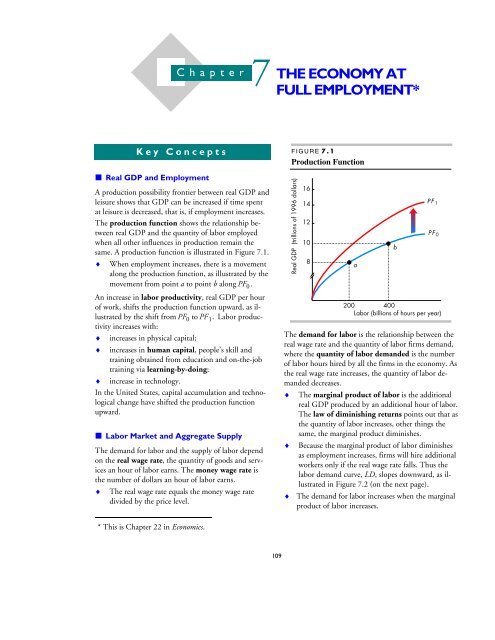




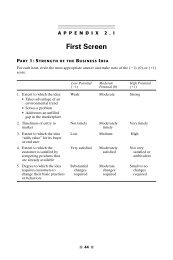





![[Productnaam] Marketingplan - Pearson](https://img.yumpu.com/26285712/1/190x132/productnaam-marketingplan-pearson.jpg?quality=85)
